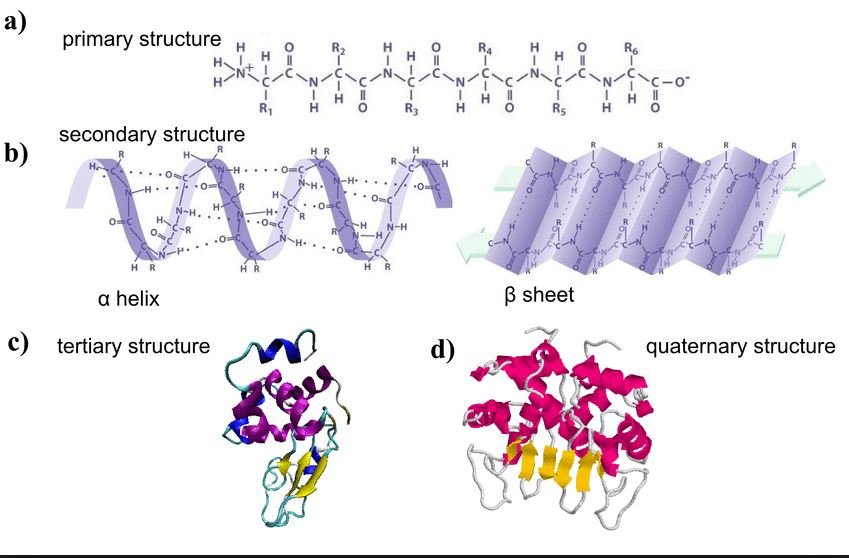What are proteins?
Proteins are “organic molecules” that are made up of amino acids – the building blocks of life. These amino acids are joined together by chemical bonds and then folded in different ways to create the 3 dimensional protein structures so important to our body’s functioning…
Now, two main categories of amino acids exist in the body. First, we’ve got essential amino acids – those that must be consumed in the diet. Next, we’ve got nonessential amino acids – those that can generally be made in the body.
Why is an adequate protein intake so important?
The protein we eat every day, upon digestion, is broken down to its individual amino acid parts and contributes to what’s called the “plasma pool of amino acids”. This plasma pool is located in our bloodstream and readily exchanges with the amino acids and proteins in our cells.
Since proteins and amino acids are necessary for the production of important molecules in our body – like enzymes, hormones, neurotransmitters, and antibodies – without an adequate protein intake, our bodies can’t function well at all. Protein also replaces worn out cells; transports various substances throughout the body; and aids in growth and repair.
What you should know
The basic recommendation for protein intake is 0.8g/kg of body mass in untrained, generally healthy adults. This translates to about 55g of protein per day for a 68kg individual. However, it should be noted that this amount is only to prevent protein deficiency.
During high intensity training, protein needs may be increased to about 1.4-2.0 g/kg body mass (Lemon et al 1981; Tarnopolsky et al 1988; Tarnopolsky et al 1991). This translates to 95-135g of protein per day for a 68kg individual.
Interestingly, these protein needs cover basic protein synthesis or protein building. However, higher amounts of protein in the diet may be vital for immune function, metabolism, satiety, weight management and performance (Flatt JP 1978; Tappy L, 1996; Blom WA et al., 2006; Latner JD, Layman et al 2003; Schwartz M, 1999; Tangney CC, et al. 2005; Kishino Y & Moriguchi S 1992; Marcos A, et al 2003).
See here for more:
http://www.unu.edu/Unupress/food2/UID07E/uid07e0c.gif
In the end, the maximal amount of protein to be consumed throughout the day for protein synthesis probably does not need to be above 1.4 – 2.0 g/kg.
Nevertheless, consuming higher levels of protein may factor into maintaining a healthy body composition, immune function and promoting satiety. Indeed, physique athletes have long relied on the rule of 2.2g of protein per kilo of body weight – or 150g per day for a 68kg individual.
For extra credit
Resistance exercise (RE) promotes increases in protein building for up to 48 hours after training (Dreyer et al 2006; Koopman et al 2006; Biolo et al 1995; Phillips et al 1997; Norton et al 2006; MacDougall et al 1995). Interestingly, during and immediately after RE, protein breakdown is increased as well. And as this breakdown exceeds synthesis, the body slips into a short-term wasting state. However, eating an adequate amount of protein during the pre- and post-exercise period can offset this catabolic state.
NOTE: Protein from plant sources and animal sources seem to work equally well in increasing muscle protein synthesis as a result of exercise (Brown et al 2004; Anthony et al 2007; Kalman et al 2007).
If you overeat protein, this extra protein can be converted into sugar or fat in the body – however with protein this happens to a lower extent than overeating carbohydrates or fat themselves. This is because the thermic effect of protein is significantly higher than that of carbohydrates and fat. Indeed, 30% of the protein’s energy goes toward digestion, absorption, and assimilation. And it only takes 8% of carbohydrate energy and 3% of fat energy to do the same.
Protein consumption can also increase levels of the hormone glucagons, which helps with body fat management (Flatt JP 1978; Tappy L, 1996; Blom WA et al., 2006; Latner JD, Schwartz M, 1999).
Normal protein intakes, in healthy individuals, pose little to no health risk. Indeed, protein intake under 2.8g/kg does not seem to impair kidney status in those with otherwise healthy kidney function (Poortmans JR & Dellalieux O 2000). Plant proteins have especially low risk toward impairing renal function (Am Diet Assoc 2003; Millward DJ 1999).
Summary and Recommendations
The maximal amount of protein to be consumed throughout the day for protein synthesis probably does not need to be above 1.4 -2.0 g/kg.
Nevertheless, consuming higher levels of protein (upwards of 2.2g per kilo of body weight) may factor into maintaining a healthy body composition, immune function and promoting satiety.
Protein consumption should be incorporated before and after exercise sessions to ensure adequate recovery.
DR JARROD D. MEERKIN PhD AEP ESSAF
References
Reeds PJ. Dispensable and indispensable amino acids for humans. J Nutr 2000;130:1835S-1840S.
Furst P & Stehle P. What are the essential elements needed for the determination of amino acid requirements in humans? J Nutr 2004;134(6 Suppl):1558S-1565S.
Soeters PB, van de Poll MC, van Gemert WG, Dejong CH. Amino acids adequacy in pathophysiological states. J Nutr 2004;134(6 Suppl):1575S-1582S.
Boelens PG, Nijveldt RJ, Houdijk AP, Meijer S, van Leeuwen PS. Glutamine alimentation in catabolic state. J Nutr 2001;131(9 Suppl):2569S-2577S.
Wu G, Fang YZ, Yang S, Lupton JR, Turner ND. Glutathione metabolism and its implications for health. J Nutr 2004;134:489-492.
American Dietetic Association. Position of the American Dietetic Association and Dietitians of Canada: Vegetarian diets. J Am Diet Assoc 2003;103:748-765.
Millward DJ. Optimal intakes of protein in the human diet. Proc Nutr Soc 1999;58:403-413.
Blom WA, Lluch A, Stafleu A, Vinoy S, Holst JJ, Schaafsma G, Hendriks HF. Effect of a high-protein breakfast on the postprandial ghrelin response. Am J Clin Nutr 2006;83:211-220.
Latner JD & Schwartz M. The effects of a high-carbohydrate, high-protein or balanced lunch on later food intake and hunger ratings. Appetite 1999;33:119–128.
Flatt JP. The biochemistry of energy expenditure. In: Bray GA ed. Recent advances in obesity research. London: Newman, 1978:211–228.
Tappy L. Thermic effect of food and sympathetic nervous system activity in humans. Reprod Nutr Dev 1996;36:391–397.
Lemon PW, Tarnopolsky MA, MacDougall JD, Atkinson SA. Protein requirements and muscle mass/strength changes during intensive training in novice bodybuilders. J Appl Physiol 1992;73:767–75.
Tangney CC, Gustashaw KA, Stefan TM, Sullivan C, Ventrelle J, Filipowski CA, Heffernan AD, Hankins J. A review: which dietary plan is best for your patients seeking weight loss and sustained weight management? Dis Mon 2005:51;284-316.
Kishino Y & Moriguchi S. Nutritional factors and cellular immune responses. Nutr Health 1992:8;133-141.
Schwartz MW & Kahn SE. Insulin resistance and obesity. Nature 1999;402:860-861.
Marcos A, Nova E, Montero A. Changes in the immune system are conditioned by nutrition. Eur J Clin Nutr 2003:57 Suppl 1;S66-S69.
Rennie MJ & Tipton KD. Protein and amino acid metabolism during and after exercise and the effects of nutrition. Annu Rev Nutr 2000;20:457-483.
Todd KS, Butterfield GE, Calloway DH. Nitrogen balance in men with adequate and deficient energy intake at three levels of work. J Nutr 1984;114:2107-2118.
Tarnopolsky MA, Atkinson SA, MacDougall JD, Chesley A, Phillips S, Schwarcz HP. Evaluation of protein requirements for trained strength athletes. J Appl Physiol 1992;73:1986-1995.
Tarnopolsky MA, Atkinson Sa, MacDougall JD, Senor BB, Lemon PW, Schwarcz H. Med Sci Sports Exerc 1991;23:326-333.
Lemon PW & Nagle FJ. Effects of exercise on protein and amino acid metabolism. Med Sci Sports Exerc 1981;13:141-149.
Dreyer HC, Fujita S, Cadenas JG, Chinkes DL, Volpi E, Rasmussen BB. J Physiol 2006;576:613-624.
Koopman R, Zorenc AH, Gransier RJ, Cameron-Smith D, van Loon LJ. Am J Physiol Endocrinol Metab 2006;290:1245-1252.
Biolo G, Maggi SP, Williams BD, Tipton KD, Wolfe RR. Am J Physiol 1995;268:E514–E520.
Phillips SM, Tipton KD, Aarsland A, Wolf SE, Wolfe RR. Am J Phisiol 1997;273:E99–E107.
Norton LE & Layman DK. J Nutr 2006;136:533S-537S.
MacDougall JD, Gibala MJ, Tarnopolsky MA, MacDonald JR, Interisano SA, Yarasheski KE. Can J Appl Physiol 1995;20:480-486.
Brown EC, DiSilvestro RA, Babaknia A, Devor ST. Nutr J 2004;3:22-27.
Anthony TG, McDaniel BJ, Knoll P, Bunpo P, Paul GL, McNurlan MA. J Nutr 2007;137:357-362.
Kalman D, Feldman S, Martinez M, Krieger DR, Tallon MJ. Effect of protein source and resistance training on body composition and sex hormones. JISSN 2007;4:4.


